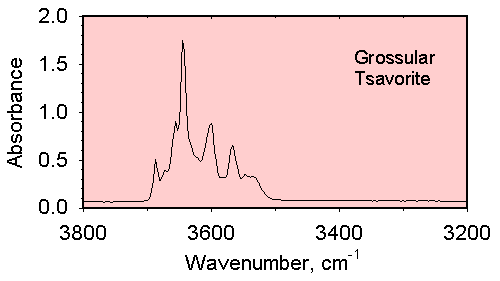
Both water molecules and hydroxide groups are found in a variety of minerals. Initial studies in the geophysics community focused on water in quartz because of its weakening effect upon the mechanical strength of this mineral. We showed that while OH groups have no effect upon the strength of quartz, the amount of water present as clusters of a few water molecules was directly associated with mechanical weakening. Hydroxide groups have subsequently been found in plagioclase feldspars, garnets, sillimanite and other aluminosilicates, olivines, clinopyroxenes, orthopyroxenes, quartz, rutile and zircon. Water molecules occur in nepheline, potassium feldspar, cordierite and other ring silicates. These molecules and ions are structurally bound in the mineral in definite sites with distinct orientations. They often persist in the minerals even at elevated temperatures (up to 1200°C).
The hydrogarnet substitution (SiO4 = +H4O4) has commonly been assumed to represent the mechanism of entry of OH into silicates. Consequently, we are particularly interested in characterizing hydrous components in garnets. We have examined hundreds of garnets of diverse composition and occurrence but rarely find one which is devoid of bound OH. When present in garnets at high concentration (more than 0.5% wt ), hydrogen is in the hydrogarnet substitution. When present at low concentration, infrared and nuclear magnetic resonance spectroscopic data suggest a variety of other incorporation mechanisms. In some silicate minerals, the incorporation of hydrogen is coupled with other light elements such as boron.
Much of our interest in hydrous components has focused on the volatile reservoirs and inventories in the upper mantle. We have identified distinctly measurable and petrologically significant quantities of OH in a variety of mantle minerals. Olivine, pyrope, clinopyroxene, rutile, kyanite, and zircon from diamond pipes and other upper mantle sources are among the most OH-rich examples of these particular species. Pyrope garnets, in particular, reflect the buildup of water in their differentiating parent magmas. We showed that the garnet megacrysts from kimberlites are more hydrous than compositionally equivalent garnets from alkali basalts, eclogitic paragenesis or from inclusions in diamonds. The typical OH concentrations of garnets from southern African mantle samples are significantly lower than those from the mantle of the Colorado Plateau. This observation re-enforces suggestions of significant large-scale regional mantle heterogeneity. We also characterized sub-micrometer inclusions in turbid diamonds which represent samples of fluids trapped in the upper mantle. The high content of H2O, CO2, carbonate, and enrichment in K, Na, P, Ti, and incompatible trace elements in these inclusions suggest that these fluids are a metasomatizing agent in the mantle.
For additional
information on calibrating the amount of hydrous components
in minerals.

Infrared spectrum of a grossular garnet in the OH stretching
region which shows multiple absorption bands which indicate that
OH ions occur in a variety of structural environments in this
crystal.